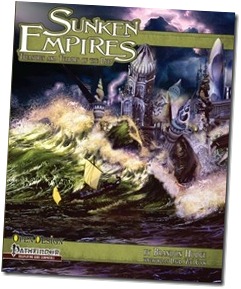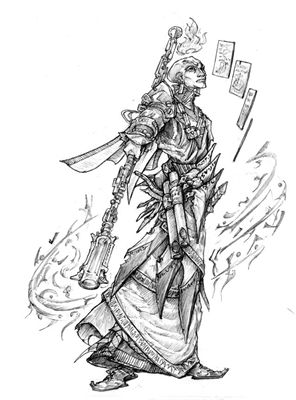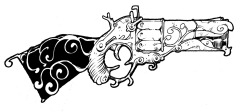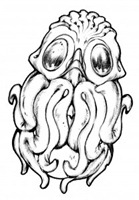 Sunken Empires is one of Open Design’s latest Pathfinder compatible products. On 82 pages you get in my opinion the definite works on underwater adventuring for Paizo’s Pathfinder RPG and much, much more. I don’t exaggerate when I tell you that this book is packed! It’s amazing how many stuff you can squeeze into a 82-pages softcover book. The softcover book sets you back $18.95, or $9.95 if you get the digital version at RPGNow.
Sunken Empires is one of Open Design’s latest Pathfinder compatible products. On 82 pages you get in my opinion the definite works on underwater adventuring for Paizo’s Pathfinder RPG and much, much more. I don’t exaggerate when I tell you that this book is packed! It’s amazing how many stuff you can squeeze into a 82-pages softcover book. The softcover book sets you back $18.95, or $9.95 if you get the digital version at RPGNow.
But let’s get into the details now. The book consists of six chapters: Lost Cities of Myth & Legend, Pelagic Characters, Aquatic Equipment & Lost Technology, Spells & Magic Items, The Sunken Enviroment and Creatures of the Deep. The introduction is done by David “Zeb” Cook and he writes about the history of the aboleth, one of the weirder monsters in fantasy roleplaying.
 Before I provide you with some information on the various chapters I have to talk about the artwork. Although the cover artwork is definitely good, it’s not really spectacular. But the interior art is top notch. While it’s black and white only, especially the chapter headers are very nicely done.
Before I provide you with some information on the various chapters I have to talk about the artwork. Although the cover artwork is definitely good, it’s not really spectacular. But the interior art is top notch. While it’s black and white only, especially the chapter headers are very nicely done.
The first chapter, called “Lost Cities of Myth & Legend” gives the reader a good overview over the legendary cities of Atlantis, Lemuria and Mu. This approach did actually surprise me, but in a good way. The book also gives some examples on how to use ideas from these cities of myth in your own game. But if you don’t want to come up with your own fantasy version of Atlantis or Lemuria, a completely fleshed out lost city is included in this chapter: Ankeshel.
Lost Ankeshel and the more recent cities of Lower and Upper Cassadega provide GMs with the perfect playground for underwater campaigns. Ankeshel was full of powerful artifacts, lost technologies and dreadful secrets that wait to be uncovered by a fearless band of adventurers. The Twin Cities of Cassadega which have been built upon the ruins of Ankeshel are the perfect starting place and home base for a campaign.
Chapter 2, “Pelagic Characters”, introduces a new race, the Maerean which are basically half-human and half-merfolk. The chapter also list some changes or additions to existing classes that makes sense in an underwater enviroment. Some of the listed additions are the Deep, Glyph, Fish, Ocean and Sea Monster domains for clerics, Underwater Armor Training for fighters and Oceanic bloodlines for Sorcerers. There’s also an extensive list of feats which give players and GMs more options to create characters with an affinity for water and underwater exploration.
 The third chapter contains a plethora of equipment from simple harpoons, cruel sawfish swords and diving suits (complete with heavy iron boots and a copper helmet) to ancient Ankeshellan weapons and armor. My favorites are the Cassadegan firearms like the Coil Rifle or the Rail Revolver, which are extremely rare and expensive, but add some steampunkish elements to the setting.
The third chapter contains a plethora of equipment from simple harpoons, cruel sawfish swords and diving suits (complete with heavy iron boots and a copper helmet) to ancient Ankeshellan weapons and armor. My favorites are the Cassadegan firearms like the Coil Rifle or the Rail Revolver, which are extremely rare and expensive, but add some steampunkish elements to the setting.
 Chapter 4 adds over 35 spells to the Pathfinder game. While you might expect that most of the spells are water-related, this isn’t the case. The Glyph school of magic allows wizards to tap into the power of runes and sigils and grants the abilities to inscribe small tiles with magic glyphs and increase the duration of certain spells (even make them permanent). Especially the glyph school can definitely used in other settings as well, but it perfectly fits the Lost City background presented in “Sunken Empires”. The chapter concludes with a section on magic items. Especially the “named items” are very creative and cool. My favorite item is the tentacled shield which looks like you’re using Cthulhu’s head to defend yourself. Yuck! And yes, the tentacles are not there for show. For some examples on what you can expect in this chapter, check out this post at the Kobold Quarterly site.
Chapter 4 adds over 35 spells to the Pathfinder game. While you might expect that most of the spells are water-related, this isn’t the case. The Glyph school of magic allows wizards to tap into the power of runes and sigils and grants the abilities to inscribe small tiles with magic glyphs and increase the duration of certain spells (even make them permanent). Especially the glyph school can definitely used in other settings as well, but it perfectly fits the Lost City background presented in “Sunken Empires”. The chapter concludes with a section on magic items. Especially the “named items” are very creative and cool. My favorite item is the tentacled shield which looks like you’re using Cthulhu’s head to defend yourself. Yuck! And yes, the tentacles are not there for show. For some examples on what you can expect in this chapter, check out this post at the Kobold Quarterly site.
Chapter 6, “The Sunken Enviroment”, provides game masters with a complete guide on how to run adventures in an underwater enviroment. It starts with details on what adventures to run in certain level rangers. While low-level games should be confined to the relative safety of the shallow waters, the sky (or rather the ocean floor) is the limit at level 13 and beyond. On several pages the different environmental zones are explained and specific rules are given.
The last chapter is called “Creatures of the Deep” and provides game masters with new monsters (even containing a new type of aquatic dragon) to add to any campaign. My favorite creature in this section is the Cnidari, a highly advanced jellyfish with all kinds of nasty special abilities. This creature acts and looks like it escaped directly from the mind of H.P. Lovecraft! The book concludes with aquatic variants of known creatures and the ecology of the aboleth.
Wow! As with the last product by Open Design I reviewed, I didn’t actually know what to expect. I was pretty surprised by the large amount of content crammed into just 82 pages. I am currently not running a Pathfinder campaign, but after reading “Sunken Empires” I might be tempted to do so. The setting presented in the book is actually a good basis for an extensive campaign. If you don’t fear to get your feet wet, you definitely should check out “Sunken Empires”.
This review is based on a read through of the softcover version of the book which has been provided by Open Design LLC for reviewing purposes.

I got the digital copy of this book as an early b-day present from a great friend (you know who you are! Thanks…) and this book is awesome wrapped in excellent. I have not read through yet but the introduction alone is worth the entrance price. Excellent book and an excellent review!